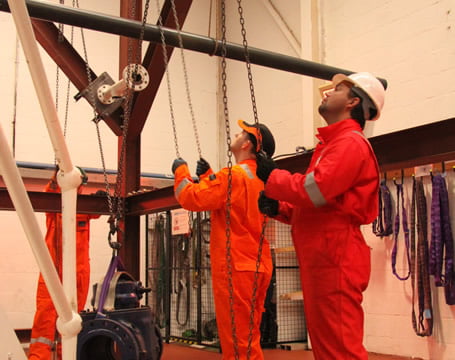Objectives
To ensure all personnel involved in rigging and slinging operations e.g. riggers, maintenance personnel, maintenance supervisors, deck crew, etc. have an understanding of the legal requirements pertaining to rigging operations, the requirements for pre-use inspection and discard criteria of lifting equipment, the safe working procedures for rigging and to ensure delegates can use lifting equipment safely and not exceed the load limit imposed on them.
Contents
Classroom instruction on the following:
- Legislation.
- Terminology used in rigging, slinging and lifting operation.
- Calculations of angles and tensions.
- Estimation of weights.
- Technical aspects, pre-use inspection, safe use and correct slinging of loads using:
- Wire rope slings.
- Polyester webbing sling.
- Round (endless) sling.
- Chains.
- Technical aspects, pre-use inspection, safe and correct use of:
- Shackles
- Eyebolts
- Plate Clamps
- Hooks
- Technical aspects, pre-use inspection, safe and correct use of:
- Chain blocks
- Pull lifts
- Tirfors
- Beams clamps
- Sheave (snatch) blocks
- Air tuggers
- Procedures for dealing with damaged or faulty equipment.
Practical instruction and delegate participation on the following:
- Pre-use inspection of equipment to be used for the practical exercises.
- Use of equipment to lift and transfer load over short distance.
- Use of equipment to lift and transfer load over distance with obstacle and height restrictions (this load normally being larger than that used in the exercise above, and would be out of balance). Delegates are required to find centre of gravity. Load to turn 180o during exercise.
- Delegates are required to pre-plan a suitable rigging spread, rig up and transfer a horizontal, out of balance load over and under obstacles and lower vertically to a designated area.
- Care of equipment after use.
NB
1. During all practical exercises delegates must be able to assess various angles and calculate tensions in all lifting equipment being used
2. The above exercises may vary depending on the practical training area being used.
The course finishes with a written course assessment.
Secure your place now!
Please chose from the dates and locations listed below. Select the number of attendees and book to secure your place today.
If none of the dates are suitable, please get in touch with your prefered dates and we will see what we can do.
| Date/Time | Location | No of Delegates |
|---|
Make an enquiry
Mandatory fields are marked with *









